The Dell XPS 13 7390 2-in-1 Review: The Ice Lake Cometh
by Brett Howse on November 15, 2019 11:30 AM ESTSystem Performance: Unleashing Ice Lake
After years of struggling to get their 10 nm process going, Intel finally has enough capacity to release their first real architecture update since Skylake. At the center of the Ice Lake platform is Intel’s Sunny Cove microarchitecture, which brings some significant improvements to the x86 core.
As a brief recap, Intel has been forced to move away from their traditional Tick Tock roadmaps, where new architectures would be initially released on a known process, and then the process would be updated with the same architecture. That methodology served the company well for many generations, but came to a grinding halt when 10 nm was delayed significantly. As a result, Ice Lake features the latest Sunny Cove architecture on the latest process, meaning there is a couple of steps here all in one go compared to the outgoing Whiskey Lake platform, featuring a refined Skylake architecture on a refined 14 nm node.
With the introduction of Ice Lake comes several improvements in Intel's CPUs. Perhaps most important for laptops like the XPS 13, Intel has finally updated their memory controller on Ice Lake, offering support for LPDDR4X-3733. Previous generation U series only supported LPDDR3, restricting not only bandwidth but also capacity. Laptops that wanted more than 16 GB of RAM had to opt for the less power friendly DDR4, but with Ice Lake that is no longer the case.
And of course, there are numerous improvements throughout the CPU pipeline to improve the CPU's performance. There is no one change that we can credit with delivering all of Ice Lake's general performance improvements, but rather Intel has gone deeper and wider in their CPU design, looking to further improve their IPC rate by finding more opportunities to execute instructions in parallel. Meanwhile, Intel has also added AVX512 support, which should significantly increase performance in certain workloads.
The tradeoff however is that 10nm Ice Lake chips can't clock as high as the 14nm Skylake-based chips they replace. Benefit of a well-refined process like 14nm is that over time, Intel has been able to provide significant increases in CPU frequency, even as they got stuck on an architecture that had not really changed for several generations in a row. So despite this Dell XPS 13 7390 offering the highest-end Core i7-1065G7 processor, the Ice Lake chip has a disadvantage in pure CPU frequency headroom: it peaks at 3.9 GHz, compared to 4.9 GHz on the latest 14 nm Comet Lake Core i7-10510U. Intel is also only offering quad-core in the 15-Watt range on Ice Lake, whereas they are now offering up to a hex-core in the 14 nm Core i7-10710U, which still provides 4.7 GHz of Turbo. Even the previous generation Whiskey Lake offered up to 4.6 GHz Turbo on quad-core, so Sunny Cove starts at a disadvantage in terms of frequency and must make up for it in instructions-per-clock to pull out a performance win.
For a deeper dive into Sunny Cove and Ice Lake, check out Ian’s dive into the platform as well as some preview testing here. But since we finally have production silicon in our hands, let’s test it out with our standard laptop bench. For reference, these results are with the laptop set in Best Performance in the Windows power settings, and Ultimate Performance in the Dell utility.
PCMark
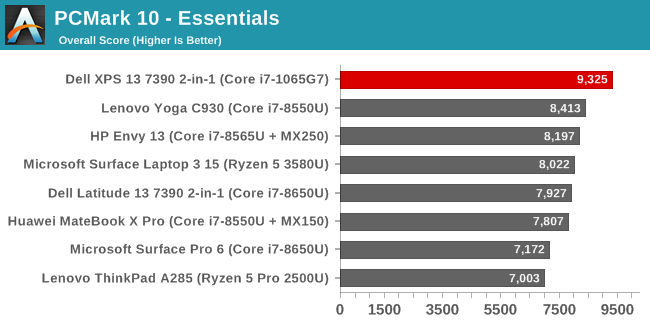
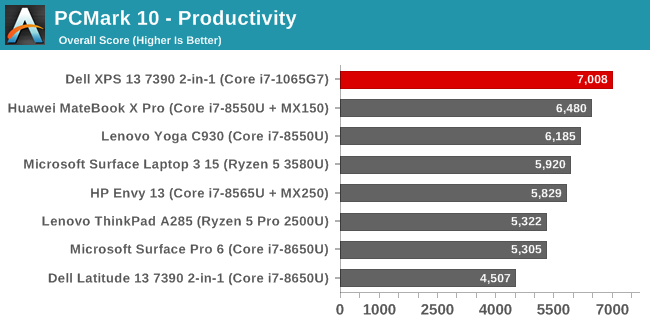
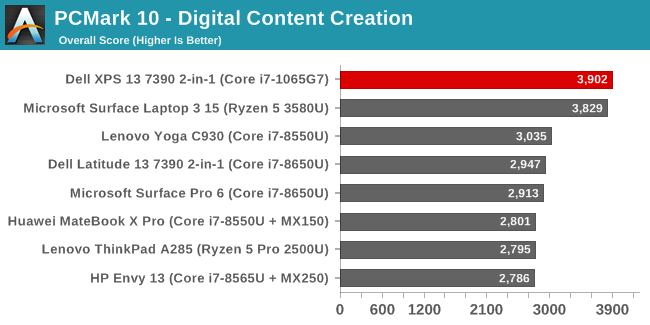

PCMark tests all aspects of a system including the CPU, GPU, and SSD, and offers a baseline for overall system performance with various tests including office applications, web, video creation, gaming, and responsiveness. The XPS 13 gets off on the right foot here, surpassing all other laptops we’ve tested in the 15-Watt range. The digital content creation test is heavily impacted by GPU performance, and we can already get a taste that the Gen11 graphics have upped the game for Intel, but the XPS 13 wins all of these by a significant margin.
Cinebench
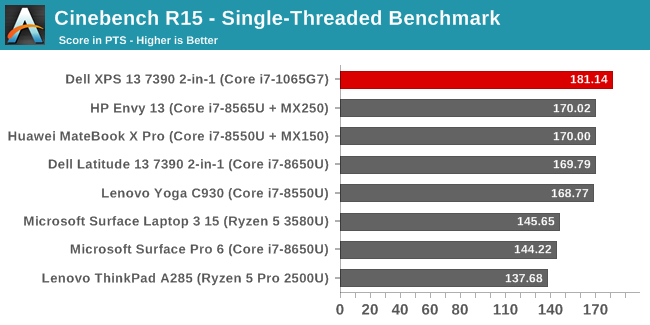
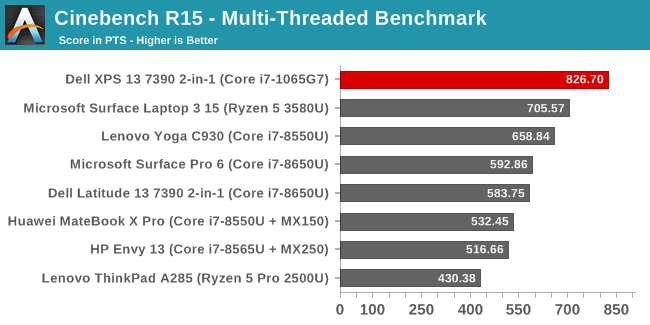
Cinebench offers both single-threaded and multi-threaded settings, allowing a closer look at individual core performance in a world of ever-expanding core counts. We’ll be transitioning to the latest R20 version soon, and have been collecting data on it for some time, but to give a broader comparison this review will stick to the R15 results, which show that Sunny Cove is indeed able to pull ahead of Whiskey Lake, despite the frequency disadvantage, and that result grows when the other cores are utilized.
x264
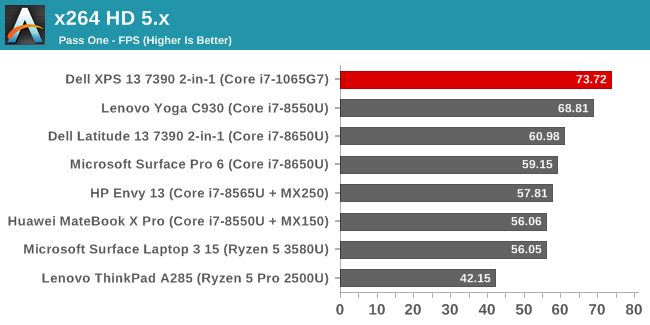
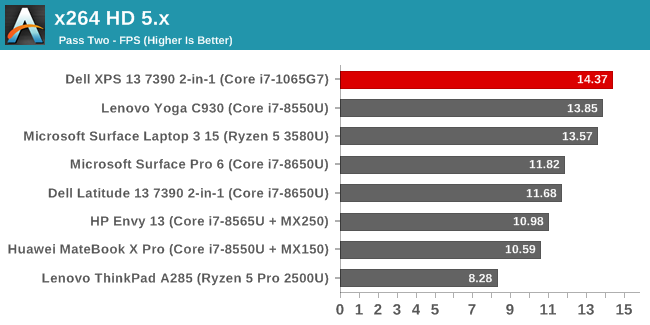
This test converts video using the CPU, and scales well with multithreading, and once again the XPS 13 pulls ahead of the pack. The test is long enough to allow the CPU to settle into a steady state for performance as well, and the Ice Lake was able to stay ahead even on a long task in a thin and light computer.
Web Tests
Web performance is heavily dependent on the underlying scripting engine of the browser, so all of our results utilize the built-in Microsoft Edge. Over time, scores can change as the browser gets updated, so be aware that any results we post are from the time the laptop was tested. Edge has somewhat regressed in performance since launch with the last couple of updates, and we’ll be moving to the new Chromium based Edge when it is released, which is looking like January 2020. At that time we’ll take the opportunity to replace some of our web tests as well.
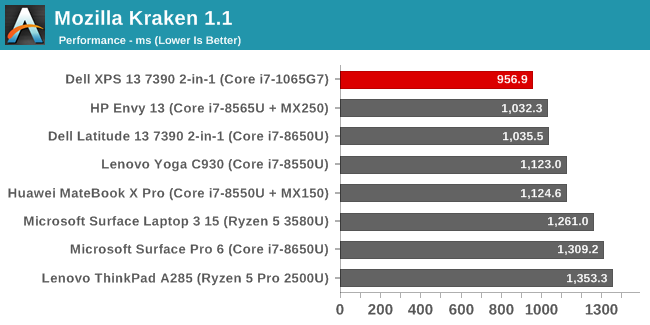
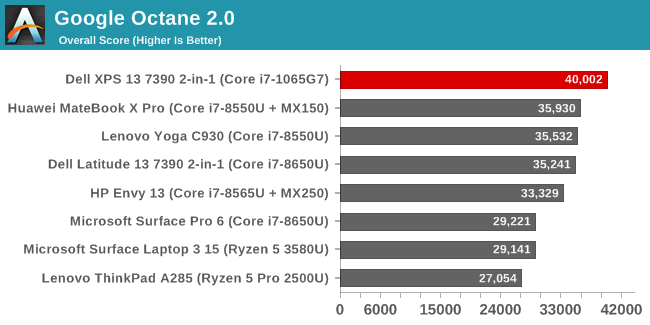
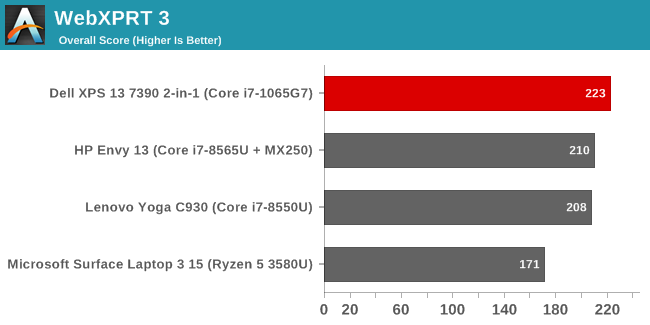

Intel has excelled at the web tests thanks to a lot of focus on being able to quickly ramp up performance when needed, which boosted all scores significantly when they introduced Speed Shift. This impacts web quite a bit due to the short nature of most scripting on the web, where the quick boost of speed allows the job to be done quicker and allows the CPU to go back to idle. Ice Lake is impressive here, offering the highest scores we’ve seen in some time.
Disk Performance
Dell shipped us the 512 GB model of the XPS 13, which in this case ships with a Toshiba PCIe NVMe SSD.
Burst performance is fantastic. SSDs are a bit of a commodity so manufacturers can and do use different models sometimes, but the device we got from Dell performed very well with this Toshiba drive.












108 Comments
View All Comments
abufrejoval - Friday, November 15, 2019 - link
First impression: This sure doesn't disappoint!1900x1200 makes a ton of sense (4k at 13" much less to my eyes), real CPU performance is better than Whiskey without draining the bottle, GPU performance is where I expected from a Skylake Iris 550 notebook I own, physical design sounds great... Perhaps I'd wait for a Lenovo variant, because I do type a lot.
With the higher-resolution, touch screen and a pen I'm not sure I'd ever be able to get it back from my daughter who can paint for hours even on a 6" mobile phone.
The most welcome surprise seemed the price: $1500 for 16GB and an i7 seems downright reasonable for what is most likely the current high-end.
Alas, when I went into the local (EU) configurator and added 32GB RAM, that added €1000 for what is essentially a €50 item (16 GB SO-DIMM). Sure it also added a 1TB NVME (€100 total or another €50 for the delta) and a 4k display I don't care about, but at that point I can't but call it the usual rip-off: I like my 4k at 42" and storage to be replacable.
So I'll hold back and onto my Lenovo S730 (16GB RAM, 1TB Samsung, AX200) for €1200 in May a little longer. That one also has an additional USB-C port in addition to the two Thunderbolts and that turns out to be really useful day-to-day, especially if your (mini) TB dock doesn't supply power, too.
But I note with satisfaction that at least in the mobile space Intel is still able to execute and I wish them well, while I won't remotely consider any Intel while there is Rome in the datacentre.
MASSAMKULABOX - Wednesday, November 20, 2019 - link
I think these are priced for the Business Market .. and its "car" pricing .. the base model is surprisingly cheap, but when you addd satnav,better wheels, heated sunroof, upgraded stereo , you've added 50% to the price. But 1000 bux for RAM is a trick learned from Apple.And where does this leave NVidia going forwrd? All their BAse(models) belong to us.
IntelUser2000 - Friday, November 15, 2019 - link
I'm suspicious of Anandtech's battery life tests for laptops.This is the only review where it doesn't regress and does significantly better than the Whiskey Lake generation.
Icelake does really well on idle but on actual usage like web browsing it plummets. Perhaps its time for them to update their tests.
yeeeeman - Saturday, November 16, 2019 - link
Phoronix review of the same laptops gets to the conclusion that ice lake is more power efficient than 14nm parts in both idle and heavy use.timecop1818 - Saturday, November 16, 2019 - link
Soldered in Killer Wireless garbage again. Not buying another Dell ever until they switch that shit out. I don't care if its made by Intel these days as long as they keep promoting that retarded branding shit in their non-gamer laptops, they will not have my money.Reflex - Saturday, November 16, 2019 - link
Literally just install the Intel AX200 drivers. Took me 5 mins and works great.timecop1818 - Saturday, November 16, 2019 - link
PCI IDs are different, no?Reflex - Sunday, November 17, 2019 - link
Doesn't seem to be. It will tell you its the incorrect driver but once you force it it will install, and future driver updates via Intel's updater will pick them up and install without a question.timecop1818 - Sunday, November 17, 2019 - link
Yeah, that means it's a different PCI ID. Because if they were included in the intel driver inf that would install without forcing. Intel would prolly be PCI\VEN_8086*DEV_xxxx and killer stuff probably uses their own vendor ID. Anyway, I'm happy with my current gemcut spectre x360 which has better screen and keyboard than XPS 13 anyway.Reflex - Sunday, November 17, 2019 - link
I hear its a good laptop, it was on my list until I noticed it didn't have a 32GB of RAM option. They both appeal to slightly different requirements IMO and I'd recommend either depending on the user and what they need.